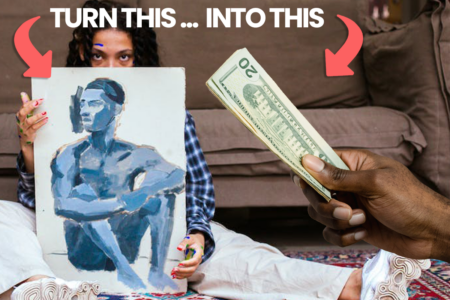Deciding to jump into freelancing is an awesome, scary, exciting rush of emotions. Unless you have money set aside, you’re probably still working your “regular” job until things really take off, but you’re ready…
…all except for one thing: you don’t have any clients.
(So your portfolio’s probably a bit thin, too.)

Get Weekly Freelance Gigs via Email
Enter your freelancing address and we'll send you a FREE curated list of freelance jobs in your top category every week.
How do you present a professional portfolio with only personal and student work (and if you’re lucky, one or two pieces from your current job)? How do you build a beautiful portfolio?
PS: Do you know what potential clients really think of your portfolio? If not, click here.
First things first…
You need at least a few really stand-out pieces in your portfolio. (Creatives get hired all the time for reasons other than their portfolio, but rarely can you even get a second glance without a beautiful one.)
So where do those stellar pieces come from? (Veterans, leave your ideas in the comments.)
Here’s where you’ve got to value education as payment. To get those first few beautiful pieces, try these avenues:
Continuing education design class(es)
Especially if you haven’t just graduated, check your local university, community college, or art school’s adult education programs for a class that promises at least one portfolio piece (email the professor and ask if you have to).
Pick a class you’ll enjoy that will also strengthen a weakness…if you need a refresher on applications, choose a software class. If learning more about social media sounds fun, check out that online marketing class.
(I took both a Design Strategies and Typography class.)
Yes, it’s going to cost you money. But it’s worth it; you’ll meet new people in the local community, get some truthful feedback on your work, and finish the class with a brand new portfolio piece.
And hey, often your professor works in the industry, so you may wind up with a mentor!
Bonus tip: Use that student card to upgrade your software for a massive discount.
Volunteer for a non-profit
Most non-profits could REALLY benefit from a good creative. But if you walk in the door unknown, you might get turned away, even if you’re willing to work pro-bono.
So, find a non-profit that benefits whatever you have a soft spot for and volunteer. (I volunteered as a dog walker for my local humane society.)

Then, once the volunteer coordinator knows you and you’re known with the paid staff as a reliable volunteer, mention your freelance skill and bring a sample sketch of a poster for the next fundraiser. Or take pictures at one of their events for fun and segue into being their event photographer. Or offer to maintain their website.
While you’re not getting paid, you’re getting valuable portfolio pieces AND an education, often with very soft deadlines. (They’re just thrilled someone as skilled as you wants to help.)
Ask for an internship
This one feels super-scary, because it means there’s a possibility of face-to-face rejection. Eeep!
But it’s not, because with today’s economy (nearly globally), pretty much every creative agency is, as Bianca put it, “biting off more than they can chew, and then chewing like crazy.”
And while they may not be officially hiring, they’re always keeping their eyes peeled and their ears open for great new talent to bring on our outsource to when their proverbial mouths are full.
So check out agencies in your area and select 3-5 top choices. (You have to know why they’re your top choices so you can explain it to them.)

Now for the hard part: phone the company and ask who to speak to about an internship opportunity. (An email is too easily dismissed. You want put them in the difficult position of having to turn you down over the phone…remember, sometimes it’s as hard to say “no” as to hear it.)
Then, dress for success and show up with your resume and best personal or student work. It really can be only 1 or 2 pieces at this point…you’re asking for an internship, not a job.
Be honest. Explain that you’re looking to break into the field, that you’re looking for some hands-on experience, and you’d like just one portfolio piece to leave with, even if you’re just a small piece of a team collaboration.
Also, offer a trial period and an end date; with strangers, companies like to know they’re not locking themselves into a bad situation where they have to ask you to leave. Something like,
“I’m only asking for two weeks as a trial period, and if that works out, a 90-day internship.”

or
“Would 2 days per week to start work for you? If it’s a good fit for both of us after one month, I’d be happy to extend it into a 6-month internship.”
Sure, at the end you’ll probably also be an expert at sorting mail or getting coffee, but you might just have a new client or part-time job in your industry (which is better than one that just pays the bills), or at the very least, connections.
And of course, your portfolio piece.
Putting it together
Once you have a few pieces to work with, you’ve got to build your portfolio correctly. (It’s different for digital versus physical portfolios.)
Tricks of the trade for all portfolios
With all portfolios, always go with quality over quantity. Three really stellar pieces make a far superior portfolio than three stellar pieces and seven average ones.
Also, always lead with your strongest piece. You want your potential client to be absolutely wowed from the get-go.
Finally, don’t forget to remove pieces as your body of work grows larger. Two years from now, your very best work now will likely (and hopefully!) pale in comparison to your very best piece then.
Digital portfolios
With less than 6 pieces, it’s best to display them nicely on your website instead of using a portfolio site like Behance. Most portfolio sites show many projects per page via thumbnails, which will tend to emphasize the size, rather than the quality, of your portfolio.
Presentation is key (I learned this the hard way). Rather than simply tossing up the final image of your work, seek out some mockup sets to show off your work in style. Check out OriginalMockups.com or Pixeden.com for some great resources.
As you build your body of work, start with the strongest and taper off. The pieces on page two or at the end of your slider are going to get far fewer views that the first 5-10 pieces even if you’ll add animations or flashy effects with a slider plugin.
Physical portfolios
Physical portfolios are becoming rarer, but have the potential for a much bigger impact than a digital portfolio.
With these, keep your portfolio to a maximum of 15 pieces. (All of them should be amazing, though.) You want to have a body of work, but you don’t want to bore your audience. Presenting your portfolio should take a maximum of 15-20 minutes.
Again, start with your absolute strongest piece followed by your second strongest, but end with your third strongest piece to finish on a high note. Fill the middle with pieces that tell stories about cost-effectiveness, overcoming obstacles, or learning a new skill.
Finally, tailor your physical portfolio to the potential client at hand. Don’t be afraid to show work outside the scope of their interest, but go heavier (if you can) on the style or type of work they’re looking for.
Questions? Comments? Suggestions?
Drop me a note in the comments and I’ll be sure to answer.
Keep the conversation going...
Over 10,000 of us are having daily conversations over in our free Facebook group and we'd love to see you there. Join us!




Thank you for sharing an interesting post. I really enjoyed it.
Hello, Nice, this is very impressive blog post. I read this,
Get good information and very amazing it. So many people like and me.
Nice article April hope that work with web developers too.
Welcome to my world of paleasure excitement
great advice, thanks. Keep it up ????
Provide such an interesting and informative stuff which i need so much to explore about Freelance land.
This is so us… Well since I’m here might wanna check our page. https://www.facebook.com/brandilism?fref=ts 🙂 We just assembled our graphics team today and creating our web portfolios. As of now you can check that one.
Very useful post for freelancers. If you are looking for a professional digital design agency then look no further than UK Logos. Visit www.uklogos.co.uk
As a thought… I’d like to recommend designers to constantly work on their portfolio, even in the event they are not proactively job hunting. The reason why is that when you do need it, if you’ve left it for some time it takes weeks to update and you miss out on so many opportunities…. True story!
To avoid the above situation again, what I have done now is created a very simple print based layout, and with each project I do, I add to it. That means I always have an updated portfolio to hand, and have the option to chop and change based on the client or company I wish to present it to. I can also do the same with a PDF too should I need to email the work.
This is really great advice, I haven’t yet read an article or a blog that touches on all these points at one time so I’ve found this very helpful.
The question I do have is as a recent graduate I’m still developing my portfolio and trying to make it stronger, but as I don’t have that much body of work outside education, I’m not getting much freelance work so I was/am considering completing a brief from YCN or D&AD to add another portfolio piece would you recommend that or could and should I try volunteering as that was another alternative I’ve been thinking about? Thanks in advance.
David
David,
Forgive me for sounding stupid, but what are YCN and D&AD?
Sorry! I’ll be happy to answer with more info. 🙂
April
YCN (You Can Now) http://www.ycn.org/ and D&AD http://www.dandad.org/ (Design and Art Direction) are companies that monitor emerging talent (they do a lot more though) they also host design competitions. Which we as a class had been tasked to complete a couple of their briefs for assignments.
David
I’m not very keen on design competitions. Essentially a company is getting their design work for free rather than work with and pay a designer to create a look meaningful for their company.
For this reason, I’d go with volunteering instead. You get to choose a cause near and dear to your heart as well as do good in the community/region/world.
Good luck!
Personally I would recommend offering your services to charities. That way you can get real world experience whilst contributing to a good cause. Fictional projects are great, but real world experience will help you get used to working with real clients, solving real problems, and will look and sound good when you present to prospect clients.
A big part of the client/designer relationship is being able to train and advise to ensure the work looks good and performs well. Inexperienced designers can sometimes be ‘puppeteered’ by clients and end up creating awful design work, so its a required skill worth getting used to so that you can keep control of the design.
Thanks for the advice Ian,
I was originally thinking to go with volunteering at a charity or something like that, as I thought it’d be more beneficial and as you said I’d be contributing to a good cause which I would find as an added bonus.
I can certainly agree with what you’re saying, there have been a few occasions where I felt I was just being as you put it ‘puppeteered’ by clients and not really producing great work it was rather degrading to be honest. But yes keeping control and executing good design work along the way couldn’t make me more happier!
Thanks for listing link to OriginalMockups.com – I didn’t know something like that existed!
Debbie,
When I found out, I was thrilled. Cuts out SO much time in updating your portfolio!
April
PS – I’m sure there are others than the ones I’ve listed, but I haven’t run into them yet.
Solid advice. I’m in the process of building a stronger portfolio, and never thought of making my work display nicely on my site (I use thumbnails as well), but it makes so much sense. Thanks
Jessica,
Glad to be of help! It’s amazing what a difference presentation makes!
April
Nice article April hope that work with web developers too.
Mohamed,
For developers, I’d make sure I had both the final look (maybe a video clip to show how it works) as well as the relevant bits of code that pertain to it, and then also a general “page” of code to show that your code is well organized, commented, and readable by someone else. In particular, you want to show off skills that tell a story — learning a new skill, a particularly neat way to solve a problem, how you overcame an obstacle, etc.
Good luck!
April